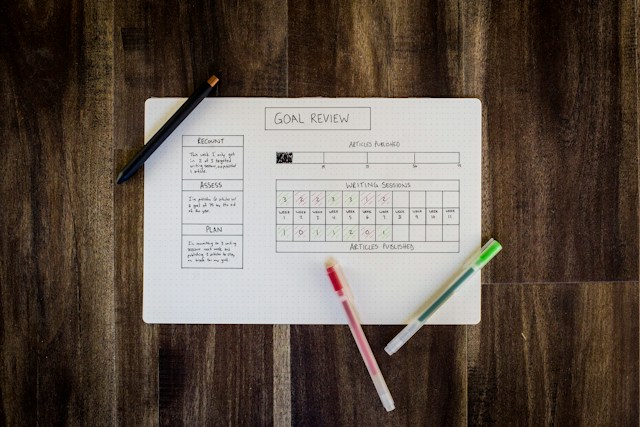TL;DR (too long; didn’t read):
Working with a web designer? Here’s what you need to know for a successful website
- Share your brand identity: This includes your logo, colors, fonts, and messaging. It helps your designer create a website that reflects your brand’s personality and values.
- Identify your target audience: Tell your designer who your ideal customer is. This helps them design a website that speaks directly to them and increases conversions.
- Outline your business goals: Do you want to boost sales, generate leads, or raise brand awareness? Knowing this helps your designer create a website that helps you achieve those goals.
- Communicate effectively: Be clear and specific with your feedback. Set expectations and use the right channels to communicate (e.g., email for simple feedback, calls for complex design issues).
By providing this information and communicating well, you’ll ensure a smooth collaboration and a website that meets your needs.
Bonus! Download our Graphic Design & Web Dev Glossary to aid in your communications.
Do you intend to work with a web designer to create your company website?
Although it’s an exciting project, it’s essential to understand what your web designer needs from you before you dive in. After all, they can’t read minds!
In this blog post, I’ll review the key information your web designer needs to know to create a website that honestly represents your business. I’ll discuss everything from your brand identity to your target audience and business goals. Plus, I’ll share some tips on interacting with your designer to ensure a smooth and successful collaboration.
So, let’s get started and make sure you keep your web designer in the loop!
The importance of understanding what your web designer needs from you.
Collaborating with a web designer to build your business website can be an exciting and enriching experience. However, it’s essential to understand that your web designer can’t read your mind, and they’ll need your input to create a website that truly represents your business.
Providing your web designer with the necessary information ensures that the end product aligns with your vision and goals. By sharing your brand identity, target audience, and business goals, you’ll help your web designer create a website that connects to your ideal customers and reflects your brand’s personality and values.

We get it; translating website dreams into reality can feel like deciphering ancient scrolls. As web designers, we are master decoders of “I kind of like blue” and can magic up a website that’s anything but cryptic. But just a heads-up, mind reading is still on our superpowers’ to-do list!
Moreover, effective communication is key to successfully collaborating with your web designer. Miscommunications can lead to frustration, delays, and extra costs. Providing your web designer with clear and specific feedback helps them understand your expectations and avoid misunderstandings.
Understanding what your web designer needs from you is essential to ensure your website project runs smoothly and meets your business goals. By providing your web designer with the necessary information and communicating effectively, you’ll be setting up your website for success.
What I’ll cover.
In this blog post, I’ll discuss the essential but frequently overlooked things your web designer needs from you when building your business website. I’ll cover three main areas:
- Brand identity and why sharing it with your web designer is essential. I’ll elaborate on what brand identity is and how your web designer can use it to create a cohesive website design.
- Target audience and how your web designer can use it to create a website that speaks to your ideal customers.
- Business goals and why it’s important to share them with your web designer to create a website that helps you achieve them.
- Advice on how to interact with your web designer effectively, stressing the significance of being unambiguous when offering feedback.
What I won‘t cover.
Technical information such as domain registration, hosting, DNS management, access etc. Each site is different, and depending on where you are in your online journey, this can vary. This information is usually discussed by most web designers during your initial discovery call.
By the end of this blog post, you’ll better understand what your web designer needs from you to create a website that genuinely represents your business and helps you achieve your goals. Let’s begin!
Your Brand Identity
What is brand identity? Why is it important?
Your business’s personality, values, and purpose are visually and verbally expressed through your brand identity. It has to do with how you interact with and make an impression on your target audience. Your brand’s name, logo, colour scheme, typography, images, and messaging all form part of its identity.

Sharing your brand identity with your web designer is crucial because it sets the foundation for your website design. Your web designer must understand your brand’s personality and values to create a website that accurately reflects it. For example, if your brand is fun and playful, your web designer may use bright colours and bold typography to convey that vibe. On the other hand, if your brand is sophisticated and elegant, your web designer may use muted colours and classic typography.
How your web designer can use your brand identity to create a unified website design.
By implementing your brand aspects throughout the website, your web designer can use your brand identity to create a unified website design. For instance, they may utilise your logo in the header or footer, your brand’s colours in the website’s colour scheme, and your brand’s fonts for headings and body text.
Your web designer may develop a powerful and enduring brand image that connects with your target audience by integrating your brand elements regularly throughout the website. Also, by being consistent, you may build credibility and trust with your audience, increasing the likelihood that they will interact with your brand.
Examples of brand elements that you should share with your web designer.
You should discuss your brand elements with your web designer to ensure they have all they need to develop a unified website design.
Your brand’s name, logo, colour scheme, typography, images, and messaging all fall under this category.
Your logo is essential to your brand identification and must be displayed prominently on your website. Using the same colours in your logo and other marketing materials can ensure that your colour scheme is consistent with your brand identification. To maintain brand consistency, the same font family and style should be used in all your marketing materials.
Sharing your brand elements enables your web designer to create a cohesive website design that accurately represents your business’s personality and values and resonates with your target audience to help you achieve your business goals.
Your Target Audience
What is a target audience, and why it’s important.
The demographic most likely to be interested in your goods or services is known as your target audience. Making a website that appeals to your ideal clients requires knowing who your target audience is. By analysing your target audience’s wants, preferences, and pain points, your web designer can construct a website that speaks directly to them, improving the possibility of conversions and sales.
How your web designer can use your target audience to create a website that speaks to your ideal customers.
Your web designer may construct a website that appeals to your ideal customers in various ways by using your target audience as inspiration. They can generate content that targets your target audience’s demands and pain points by using language and tone that appeals to them, appealing visuals, and addressing their needs.
You should provide your web designer with demographic and psychographic details about your prospective clients to assist them in constructing a website that speaks to your target audience. Age, gender, hobbies, values, and habits are just a few examples of the data included.

Lost in a sea of signs, or a glowing beacon for your tribe? Knowing your target audience makes the different between being seen and being lost.
Examples of demographic and psychographic information that you should share with your web designer.
For instance, you could employ a colour scheme and imagery that portrays a sense of calmness and serenity if your target audience is predominantly women between the ages of 25 and 35 who are interested in health and well-being.
Like this, you could employ a livelier and more energising colour scheme and images if your target audience is predominantly males between the ages of 18 and 24 who are gamers.
By giving them this information, You can ensure your web designer has everything they need to build a website that connects directly to your ideal clients. In the end, this will assist you in reaching your business objectives and increasing conversions and revenue.
Your Business Goals
What are business goals, and why are they important?
The goals you wish to attain with your website are those related to your business. Your website should be created with the business’s goals in mind, whether those objectives are boosting sales, generating leads, enhancing brand recognition, or something else entirely.
How your web designer can use your business goals to create a website that helps you achieve them
Your web designer must be aware of your business’s objectives if they are to build a website that will assist you in achieving them. Your web designer may construct a website that is customised to your unique wants and ambitions by learning about your business goals.
Examples of business goals that you should share with your web designer.

For instance, your web designer might concentrate on developing a user-friendly e-commerce platform that makes it simple for clients to buy your products if your main company objective is to grow sales. In contrast, if generating leads is your main company objective, your web designer might concentrate on developing a landing page with a prominent call-to-action that entices visitors to provide their contact information.
You can ensure your web designer has everything they need to construct a website to help you achieve your business goals by giving them information about them. In addition to assisting you in achieving your business goals, doing this will ensure that your website is a valuable resource for your business.
It is crucial to communicate with your web designer about your brand identity, target market, and business objectives to create a website that fulfils your unique requirements. By working together and sharing information, you can make sure that your website effectively achieves your business goals and drives success.
Effective Communication with Your Web Designer
Working with your web designer requires effective communication, as with any successful cooperation. Here are some suggestions for having productive conversations with your web designer:
- Be precise and explicit: When giving your web designer comments, be as precise and straightforward as possible. Give specific examples rather than sweeping generalisations. This will make it easier for your web designer to understand exactly what you’re seeking and produce a website that satisfies your requirements.
- Set specific expectations: Ensure that you and your web designer agree regarding deadlines, deliverables, and other requirements. This will assist you in avoiding misunderstandings and ensuring the success of your project.
- Use the appropriate communication channels: Various forms of feedback require various forms of communication. For instance, a phone or video call may be more efficient than an email if you need to discuss a complicated design issue. Make sure you’re using the appropriate channels for communicating the required feedback.
- Feedback should be given promptly if you want to keep your project on track. Ensure you’re delivering input on time and reacting quickly to your web designer’s requests for comments.
By following these tips, you can ensure that you communicate effectively with your web designer and avoid common miscommunications. Some common miscommunications include:
- Misunderstandings about design preferences: If you have a specific design preference, make sure that you communicate it clearly to your web designer. Avoid vague comments like “make it pop” or “make it look modern”, and provide specific examples or references to help your web designer understand what you’re looking for.
- Misunderstandings about timelines: Make sure you and your web designer are on the same page regarding timelines and deadlines. If you need something by a specific date, communicate it to your web designer so they can plan accordingly.
- Misunderstandings about deliverables: Make sure you and your web designer clearly understand what is included in your project scope and what is not. This will help you avoid misunderstandings and ensure that you get exactly what you’re looking for.
By communicating effectively and avoiding these common miscommunications, you can ensure that your collaboration with your web designer is successful and that you get a website that meets your needs and surpasses your expectations.
It’s about working together
Your web designer is an invaluable resource in helping you establish a successful online presence for your business. Be bold and provide them with all the information they require to produce a website that satisfies your needs and surpasses your expectations. Together, you can design a website that represents the essence of your business, appeals to your target market, and advances your business’s goals.
So, if you’re a small business owner who is about to collaborate with a web designer to build your business website, take the time to understand what your web designer needs from you. Doing so can ensure successful collaboration and create a website that sets your business up for success.



